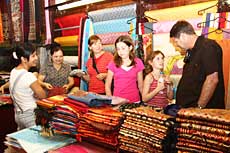The Vietnamese Ao Dai has graced the world's catwalks, acclaimed for its luxuriously elegant appearance as well as its softness and lightness.
 The beauty of the traditional long dress partly rests on the hand-made silk from traditional craft villages throughout the country. It is not surprising that Vietnamese designers are using the home-spun materials to wow fashion circles in Paris and Milan.
The beauty of the traditional long dress partly rests on the hand-made silk from traditional craft villages throughout the country. It is not surprising that Vietnamese designers are using the home-spun materials to wow fashion circles in Paris and Milan.
Chinese, Japanese, and Italian silks enjoy good reputation but Vietnamese silk can boast an unbleached, natural quality with its own distinctive charm in Asia.
According to the Book of Han, Lac Viet's silk production dated back to 2000 BC: "In a year, there were two rice crops and eight silk crops". Some historical documents proved silk appearance in the sixth dynasty of Hung Vuong (ancient Vietnamese).
Silk, called lụa in Vietnamese, was considered an extravagant luxury in feudal times, associated with wealth and success. It was only worn by Kings, Queens, and mandarins. Vietnam's various dynasties developed strict rules regimenting the colour, ornamentation, style, and fabric of clothes worn by aristocrats.
Yếm- traditional silken bra in Vietnam
The obvious value of Vietnamese silk is undeniable when many tourists are seen leaving the country with at least one piece of material, those in different designs such as highly durable Lismore Bud silk, plain silk, embroidered silk, and the versatile and absorbent satin silk.
Silk weaving is ubiquitous in Vietnam, but one of the most traditionally illustrious silk villages is located in the northwest of Ha Dong town, around 10 km from Hanoi. Van Phuc is proud to be the most ancient silk village, which has produced smooth, lightweight silks for more than 1,200 years. The special beauty of Van Phuc silk has inspired many Vietnamese poems, songs, and movies (including the award-winning film The White Silk Dress).
The decorative patterns of Van Phuc silk are used as models by Vietnamese craftsmen and artisans when applying images to other thin and fibrous materials. Weavers here draw, spin, glue, and knit cords into silk, brocade, satin, chiffon, bằng, quế, sa, and đũi (traditional types of cloth). They feature sophisticated patterns of birds, animals, flowers and leaves' even the famous 20m long "two dragons kowtowing the moon".
The woven flower patterns are startlingly realistic and their weavers so skilled that almost any customer request can be met. Most tourists therefore insist on visiting Van Phuc village to explore the traditional silk-making industry during their stay in Hanoi.
Nowadays, the fine and lustrous cloth that originates from the cocoon of the silkworm has become more affordable for ordinary folk. Vietnamese silk is currently enjoying a fashion renaissance, its adaptability perfect for the range of designs required by modern life.
Though the days when Vietnamese silk was reserved for nobility are long gone, its connotations of romance and luxury will never fade. 2,000 years of Vietnamese weavers have burnished the fabric with the aspirational dreams and sentiments of generations.